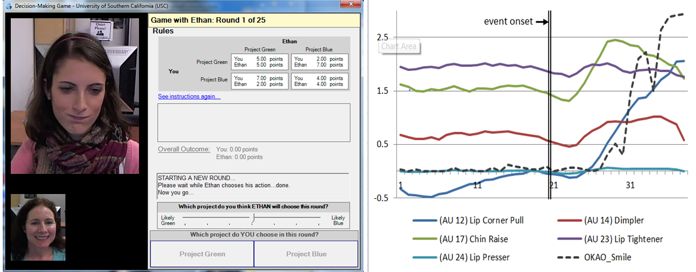The American team is directed by Jonathan Gratch and investigates social appraisal in contexts where senders have competitive incentives to misrepresent their true feelings to receivers. During a car sale, for example, the buyer and seller may wish to mislead one another concerning their minimum acceptable offer and use emotions to convey these false aspirations, but both parties are also aware of the potential for deception. Interpersonal miscalibration of appraisals and perceived appraisals may arise in such situations because, on the one hand, parties may regulate or misrepresent their appraisal of the situation, and, on the other hand, they may falsely assume that the other is engaging in such regulation. Our research addresses situations of this kind using experimental games with “virtual confederates” to systematically examine the impact of emotional displays.
Video 1. Emotional expressions of virtual confederates
We plan a series of studies to examine the role of emotional communication and social appraisal in influencing outcomes in such negotiations. The first studies use video-transmitted interactions between pairs of actual participants (not confederates) to examine how a priori expectations of cooperation and the incentive structures interact to influence emotional expression and emotional alignment. Dependent variables include concession rates, insight (i.e., the difference between achieved and theoretically-optimal agreements), and patterning of facial expressions (of specific interest will be whether these expressions reflect true preferences, strategic misrepresentations, or are uncorrelated with task appraisals).
Video 2. Negotiations with a virtual confederate
Results from the first series of studies will inform behaviour of virtual confederates for subsequent studies. We will attempt to replicate prior findings on the impact of non-contingent emotional displays (e.g., angry negotiators) using virtual confederates. However, we also aim to create evidence-based contingent behaviour strategies based on an analysis of the video-transmitted interactions. For example, we anticipate that participants will not simply exhibit anger, but that anger expression will be contingent on the size of their opponent’s concession and how this offer relates to their specific priorities.

Figure 1. The left-hand image illustrates a video-transmitted Prisoner’s Dilemma game. The right-hand graph illustrates automatic annotation of the video-captured facial displays of the woman at the top of the game interface using the CERT facial-action-unit analysis toolkit (Bartlett et al., 2006), showing how action units change over time in response to game events. Images and analysis show real data from games related to those used in this project (Gratch et al., 2013).

